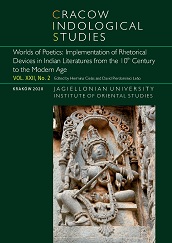Pushing Mind to the Limits: Visual Forms in Dharmadāsa’s Vidagdhamukhamaṇḍana
Pushing Mind to the Limits: Visual Forms in Dharmadāsa’s Vidagdhamukhamaṇḍana
Author(s): Hermina CielasSubject(s): Studies of Literature, Cognitive linguistics, Other Language Literature, Cognitive Psychology, 6th to 12th Centuries
Published by: KSIĘGARNIA AKADEMICKA Sp. z o.o.
Keywords: citrakāvya; citrabandha; Dharmadāsa; visual poetry; riddles;
Summary/Abstract: People have always tried to master memorizing - a factor playing an immense role in the circulation of Indian literature. To commit to memory seemed to be one of the characteristics of educated people, the source of knowledge and respect. Literary riddles were a great tool for shaping and sharpening the mind. As multi-leveled exercises they engage different parts of the brain in the process of memorizing. Dharmadāsa’s work, Vidadghamukhamaṇḍana, “The Ornament of the Wise Man’s Mouth” (ca. 11th century), served as a manual helping to enhance cognitive skills. Bandhas, visual forms included in Vidadghamukhamaṇḍana combined with other literary riddles, create complex enigmas, pushing minds to the limits and forcing those who accept the challenge to unveil multiple layers, denotations and connotations in the text. The readers/listeners stretch their abilities to solve the riddles set by the author, who has crossed the boundaries of poetical compositions and rules concerning the creation of visual forms in Sanskrit literature. Bandhas of this kind play an important role in the history and development of Indian visual poetry. Their unique character and function allow us to distinguish a coherent trend in the tradition of Sanskrit citrakāvya.
Journal: Cracow Indological Studies
- Issue Year: 21/2019
- Issue No: 2
- Page Range: 1-23
- Page Count: 23
- Language: English

